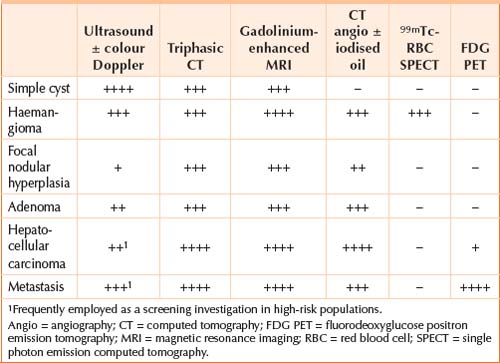Chapter 44 MASS IN THE LIVER
APPROACHES TO THE LIVER MASS
Incidental liver mass in the well patient
With the widespread use of ultrasound for the investigation of a wide range of abdominal symptoms, focal liver masses are frequently identified. Most of these represent benign pathology, and further imaging is only required if there is doubt as to the nature of the mass on the initial study. Patients with a simple cyst can be reassured and no further investigation is needed. A recent study has shown that if a focal mass has the typical appearance of a haemangioma on ultrasound the risk of missing a malignant lesion is less than 0.5%, so further imaging is not required. Other focal lesions usually require further investigation, depending on the initial form of imaging employed.
BENIGN LIVER MASSES
Cavernous haemangioma
Cavernous haemangiomas are the most common benign hepatic tumour, occur in 5% of the population and are female predominant. On ultrasound they are well circumscribed, uniform, hyperechoic lesions without a peripheral halo. When found incidentally in the otherwise well patient, classical ultrasound features are usually sufficient to establish the diagnosis and further investigation or treatment is unnecessary. Atypical haemangiomas can present a diagnostic challenge but triphasic computed tomography (CT) or, preferably, gadolinium-enhanced magnetic resonance imaging (MRI) will confirm the diagnosis in the majority of cases and have largely replaced 99mTc-labelled red blood cell studies (Table 44.1).
Focal nodular hyperplasia
Focal nodular hyperplasia (FNH) is a well circumscribed mass that typically displays a central stellate scar, a feature that is best seen with triphasic CT or gadolinium-enhanced MRI (Table 44.1). FNH is female predominant, usually asymptomatic and does not progress to malignancy. Ultrasound displays an isoechoic or hypoechoic lesion and colour Doppler may display vessels radiating outward from the artery within the central scar. Most lesions are less than 5 cm diameter and solitary. Occasionally differentiation from fibrolamellar HCC may be difficult.
Stay updated, free articles. Join our Telegram channel

Full access? Get Clinical Tree









